利用受激发射损耗_STED_显微术突破远场衍射极限
- 格式:pdf
- 大小:618.38 KB
- 文档页数:6
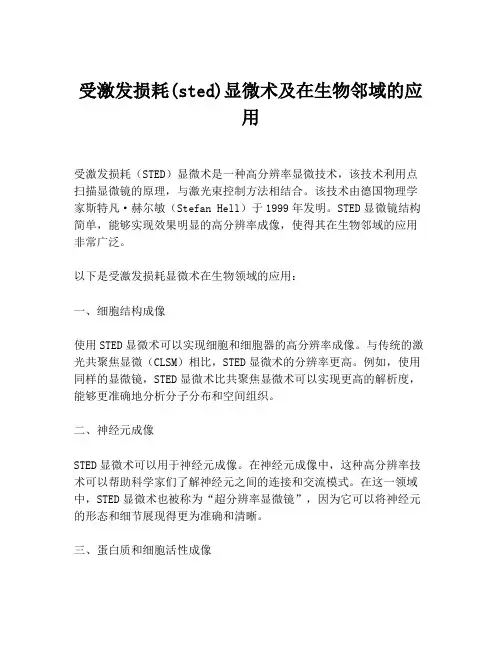
受激发损耗(sted)显微术及在生物邻域的应
用
受激发损耗(STED)显微术是一种高分辨率显微技术,该技术利用点扫描显微镜的原理,与激光束控制方法相结合。
该技术由德国物理学家斯特凡·赫尔敏(Stefan Hell)于1999年发明。
STED显微镜结构简单,能够实现效果明显的高分辨率成像,使得其在生物邻域的应用非常广泛。
以下是受激发损耗显微术在生物领域的应用:
一、细胞结构成像
使用STED显微术可以实现细胞和细胞器的高分辨率成像。
与传统的激光共聚焦显微(CLSM)相比,STED显微术的分辨率更高。
例如,使用同样的显微镜,STED显微术比共聚焦显微术可以实现更高的解析度,能够更准确地分析分子分布和空间组织。
二、神经元成像
STED显微术可以用于神经元成像。
在神经元成像中,这种高分辨率技术可以帮助科学家们了解神经元之间的连接和交流模式。
在这一领域中,STED显微术也被称为“超分辨率显微镜”,因为它可以将神经元的形态和细节展现得更为准确和清晰。
三、蛋白质和细胞活性成像
STED显微术能够实现蛋白质和细胞活性的实时监测。
这种技术使得科学家们能够在细胞和分子水平上观察生物过程和细胞反应,为研究细胞信号传递和疾病发展提供了更可靠的数据。
总之,随着STED显微技术的不断进步,其在生物邻域的应用将会越来越广泛。
该技术的高分辨成像特征将为生命科学研究提供强有力的支持,帮助科学家们更深入地了解生物世界的奥秘。
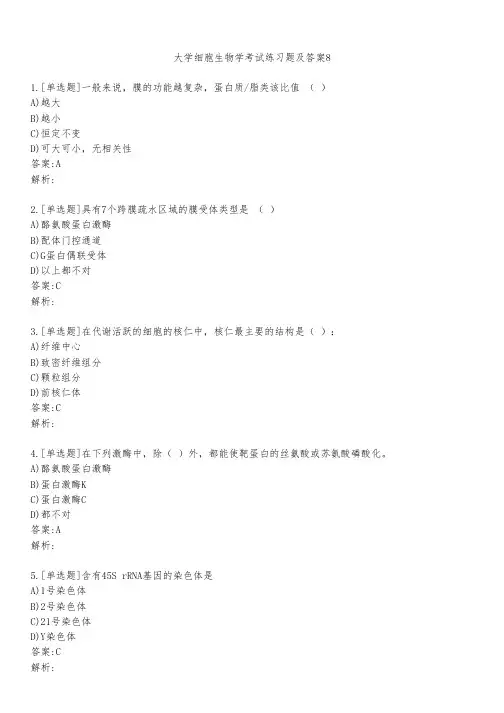
大学细胞生物学考试练习题及答案81.[单选题]一般来说,膜的功能越复杂,蛋白质/脂类该比值 ( )A)越大B)越小C)恒定不变D)可大可小,无相关性答案:A解析:2.[单选题]具有7个跨膜疏水区域的膜受体类型是 ( )A)酪氨酸蛋白激酶B)配体门控通道C)G蛋白偶联受体D)以上都不对答案:C解析:3.[单选题]在代谢活跃的细胞的核仁中,核仁最主要的结构是( ):A)纤维中心B)致密纤维组分C)颗粒组分D)前核仁体答案:C解析:4.[单选题]在下列激酶中,除( )外,都能使靶蛋白的丝氨酸或苏氨酸磷酸化。
A)酪氨酸蛋白激酶B)蛋白激酶KC)蛋白激酶CD)都不对答案:A解析:5.[单选题]含有45S rRNA基因的染色体是A)1号染色体B)2号染色体C)21号染色体D)Y染色体6.[单选题]一般来讲,脂肪酸链的长度越长,膜的流动性 ( )A)越大B)越小C)不变D)以上都不对答案:B解析:7.[单选题]负责从内质网到高尔基体物质运输的是( )。
A)网格蛋白有被小泡B)COPⅡ有被小泡C)COPⅠ有被小泡D)胞内液泡答案:B解析:A项,网格蛋白有被小泡主要负责蛋白质从高尔基体TGN向质膜和胞内体及溶酶体运输;C项,COPⅠ有被小泡负责将内质网逃逸蛋白质从高尔基体返回内质网等。
8.[单选题]下列有关内外核膜的描述哪个是不正确的?( )A)内外层核膜的厚度不同B)核周间隙宽度因细胞种类和功能状态而改变C)由于外层核膜表面附着核糖体,可以看作是糙面内质网的特化区域D)内层核膜上的一些特有的蛋白质成分与核纤层结合答案:A解析:细胞核的内外核膜都由磷脂双分子层和镶嵌在其中的蛋白质构成,在成分、厚度、性质方面都是一样的。
9.[单选题]染色体出现成倍状态发生于细胞周期中的( )[湖南大学2007研]A)G2期和早M期B)G1期和S期C)晚M期和Gl期D)G0期和G1期答案:A解析:S期开始DNA的复制,同时染色体也在这个阶段完成复制。
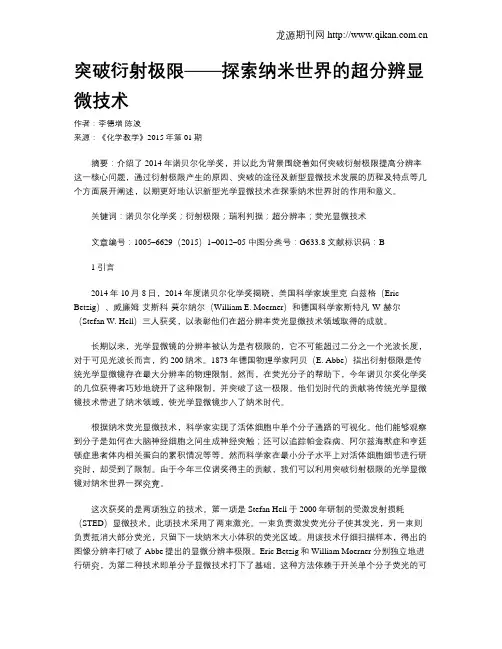
突破衍射极限——探索纳米世界的超分辨显微技术作者:李德增陈波来源:《化学教学》2015年第01期摘要:介绍了2014年诺贝尔化学奖,并以此为背景围绕着如何突破衍射极限提高分辨率这一核心问题,通过衍射极限产生的原因、突破的途径及新型显微技术发展的历程及特点等几个方面展开阐述,以期更好地认识新型光学显微技术在探索纳米世界时的作用和意义。
关键词:诺贝尔化学奖;衍射极限;瑞利判据;超分辨率;荧光显微技术文章编号:1005–6629(2015)1–0012–05 中图分类号:G633.8 文献标识码:B1 引言2014年10月8日,2014年度诺贝尔化学奖揭晓,美国科学家埃里克·白兹格(Eric Betzig)、威廉姆·艾斯科·莫尔纳尔(William E. Moerner)和德国科学家斯特凡·W·赫尔(Stefan W. Hell)三人获奖,以表彰他们在超分辨率荧光显微技术领域取得的成就。
长期以来,光学显微镜的分辨率被认为是有极限的,它不可能超过二分之一个光波长度,对于可见光波长而言,约200纳米。
1873年德国物理学家阿贝(E. Abbe)指出衍射极限是传统光学显微镜存在最大分辨率的物理限制。
然而,在荧光分子的帮助下,今年诺贝尔奖化学奖的几位获得者巧妙地绕开了这种限制,并突破了这一极限。
他们划时代的贡献将传统光学显微镜技术带进了纳米领域,使光学显微镜步入了纳米时代。
根据纳米荧光显微技术,科学家实现了活体细胞中单个分子通路的可视化。
他们能够观察到分子是如何在大脑神经细胞之间生成神经突触;还可以追踪帕金森病、阿尔兹海默症和亨廷顿症患者体内相关蛋白的累积情况等等。
然而科学家在最小分子水平上对活体细胞细节进行研究时,却受到了限制。
由于今年三位诺奖得主的贡献,我们可以利用突破衍射极限的光学显微镜对纳米世界一探究竟。
这次获奖的是两项独立的技术。
第一项是Stefan Hell于2000年研制的受激发射损耗(STED)显微技术。
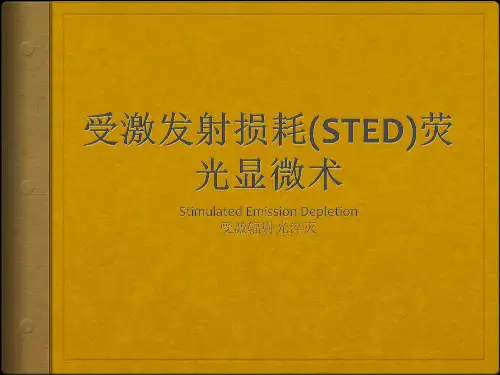
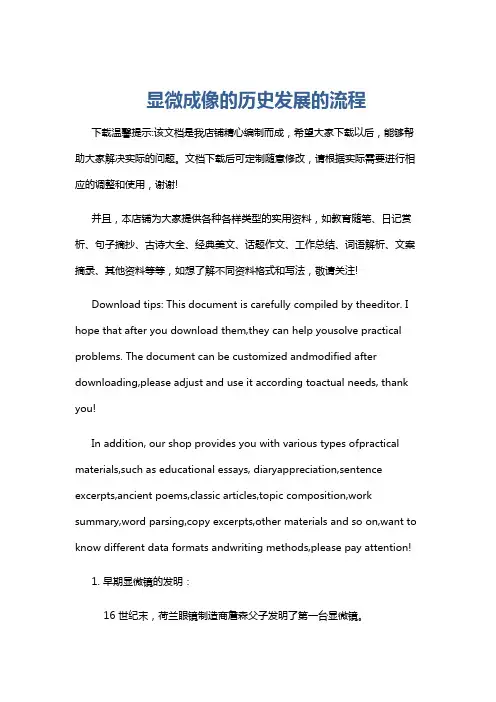
显微成像的历史发展的流程下载温馨提示:该文档是我店铺精心编制而成,希望大家下载以后,能够帮助大家解决实际的问题。
文档下载后可定制随意修改,请根据实际需要进行相应的调整和使用,谢谢!并且,本店铺为大家提供各种各样类型的实用资料,如教育随笔、日记赏析、句子摘抄、古诗大全、经典美文、话题作文、工作总结、词语解析、文案摘录、其他资料等等,如想了解不同资料格式和写法,敬请关注!Download tips: This document is carefully compiled by theeditor. I hope that after you download them,they can help yousolve practical problems. The document can be customized andmodified after downloading,please adjust and use it according toactual needs, thank you!In addition, our shop provides you with various types ofpractical materials,such as educational essays, diaryappreciation,sentence excerpts,ancient poems,classic articles,topic composition,work summary,word parsing,copy excerpts,other materials and so on,want to know different data formats andwriting methods,please pay attention!1. 早期显微镜的发明:16 世纪末,荷兰眼镜制造商詹森父子发明了第一台显微镜。
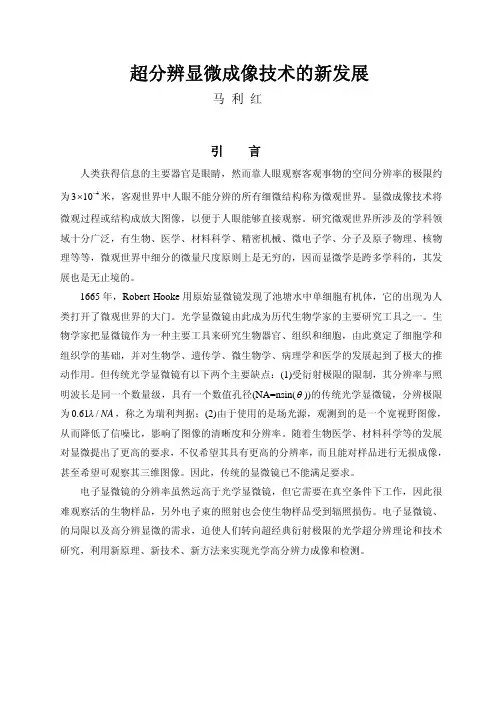
超分辨显微成像技术的新发展马利红引言人类获得信息的主要器官是眼睛,然而靠人眼观察客观事物的空间分辨率的极限约为4´米,客观世界中人眼不能分辨的所有细微结构称为微观世界。
显微成像技术将310-微观过程或结构成放大图像,以便于人眼能够直接观察。
研究微观世界所涉及的学科领域十分广泛,有生物、医学、材料科学、精密机械、微电子学、分子及原子物理、核物理等等,微观世界中细分的微量尺度原则上是无穷的,因而显微学是跨多学科的,其发展也是无止境的。
1665年,Robert Hooke用原始显微镜发现了池塘水中单细胞有机体,它的出现为人类打开了微观世界的大门。
光学显微镜由此成为历代生物学家的主要研究工具之一。
生物学家把显微镜作为一种主要工具来研究生物器官、组织和细胞,由此奠定了细胞学和组织学的基础,并对生物学、遗传学、微生物学、病理学和医学的发展起到了极大的推动作用。
但传统光学显微镜有以下两个主要缺点:(1)受衍射极限的限制,其分辨率与照明波长是同一个数量级,具有一个数值孔径(NA=nsin(q))的传统光学显微镜,分辨极限l,称之为瑞利判据;(2)由于使用的是场光源,观测到的是一个宽视野图像,为0.61/NA从而降低了信噪比,影响了图像的清晰度和分辨率。
随着生物医学、材料科学等的发展对显微提出了更高的要求,不仅希望其具有更高的分辨率,而且能对样品进行无损成像,甚至希望可观察其三维图像。
因此,传统的显微镜已不能满足要求。
电子显微镜的分辨率虽然远高于光学显微镜,但它需要在真空条件下工作,因此很难观察活的生物样品,另外电子束的照射也会使生物样品受到辐照损伤。
电子显微镜、的局限以及高分辨显微的需求,迫使人们转向超经典衍射极限的光学超分辨理论和技术研究,利用新原理、新技术、新方法来实现光学高分辨力成像和检测。
第一节基于传统的Rayleigh分辨率意义下的超分辨理论光学系统的空间分辨率是一个非常有用的概念,但是关于它的具体定义和描述却有许多不同的见解。
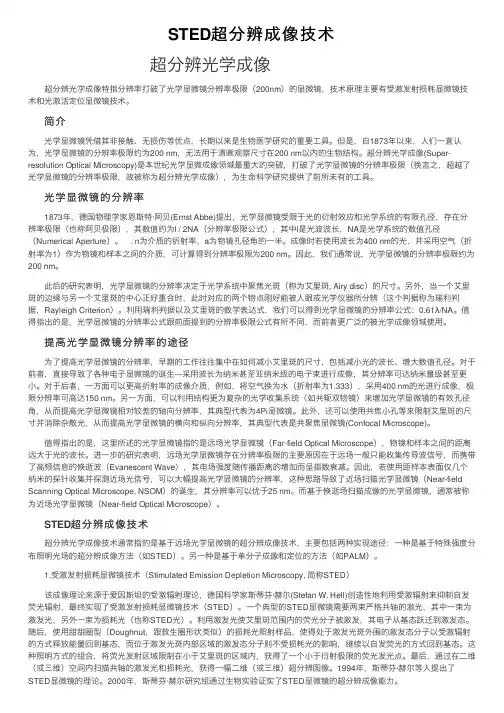
STED超分辨成像技术超分辨光学成像超分辨光学成像特指分辨率打破了光学显微镜分辨率极限(200nm)的显微镜,技术原理主要有受激发射损耗显微镜技术和光激活定位显微镜技术。
简介光学显微镜凭借其⾮接触、⽆损伤等优点,长期以来是⽣物医学研究的重要⼯具。
但是,⾃1873年以来,⼈们⼀直认为,光学显微镜的分辨率极限约为200 nm,⽆法⽤于清晰观察尺⼨在200 nm以内的⽣物结构。
超分辨光学成像(Super-resolution Optical Microscopy)是本世纪光学显微成像领域最重⼤的突破,打破了光学显微镜的分辨率极限(换⾔之,超越了光学显微镜的分辨率极限,故被称为超分辨光学成像),为⽣命科学研究提供了前所未有的⼯具。
光学显微镜的分辨率1873年,德国物理学家恩斯特·阿贝(Ernst Abbe)提出,光学显微镜受限于光的衍射效应和光学系统的有限孔径,存在分辨率极限(也称阿贝极限),其数值约为l / 2NA(分辨率极限公式),其中l是光波波长,NA是光学系统的数值孔径(Numerical Aperture)。
, n为介质的折射率,a为物镜孔径⾓的⼀半。
成像时若使⽤波长为400 nm的光,并采⽤空⽓(折射率为1)作为物镜和样本之间的介质,可计算得到分辨率极限为200 nm。
因此,我们通常说,光学显微镜的分辨率极限约为200 nm。
此后的研究表明,光学显微镜的分辨率决定于光学系统中聚焦光斑(称为艾⾥斑, Airy disc)的尺⼨。
另外,当⼀个艾⾥斑的边缘与另⼀个艾⾥斑的中⼼正好重合时,此时对应的两个物点刚好能被⼈眼或光学仪器所分辨(这个判据称为瑞利判据,Rayleigh Criterion)。
利⽤瑞利判据以及艾⾥斑的数学表达式,我们可以得到光学显微镜的分辨率公式:0.61λ/NA。
值得指出的是,光学显微镜的分辨率公式跟前⾯提到的分辨率极限公式有所不同,⽽前者更⼴泛的被光学成像领域使⽤。
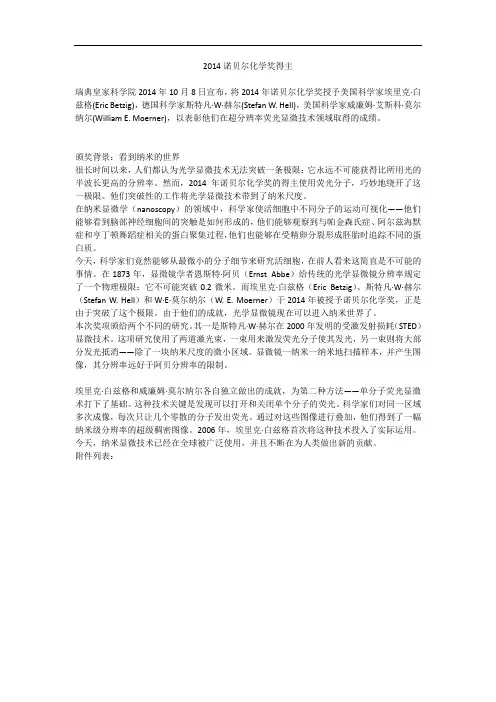
2014诺贝尔化学奖得主瑞典皇家科学院2014年10月8日宣布,将2014年诺贝尔化学奖授予美国科学家埃里克·白兹格(Eric Betzig),德国科学家斯特凡·W·赫尔(Stefan W. Hell),美国科学家威廉姆·艾斯科·莫尔纳尔(William E. Moerner),以表彰他们在超分辨率荧光显微技术领域取得的成绩。
颁奖背景:看到纳米的世界很长时间以来,人们都认为光学显微技术无法突破一条极限:它永远不可能获得比所用光的半波长更高的分辨率。
然而,2014年诺贝尔化学奖的得主使用荧光分子,巧妙地绕开了这一极限。
他们突破性的工作将光学显微技术带到了纳米尺度。
在纳米显微学(nanoscopy)的领域中,科学家使活细胞中不同分子的运动可视化——他们能够看到脑部神经细胞间的突触是如何形成的,他们能够观察到与帕金森氏症、阿尔兹海默症和亨丁顿舞蹈症相关的蛋白聚集过程,他们也能够在受精卵分裂形成胚胎时追踪不同的蛋白质。
今天,科学家们竟然能够从最微小的分子细节来研究活细胞,在前人看来这简直是不可能的事情。
在1873年,显微镜学者恩斯特·阿贝(Ernst Abbe)给传统的光学显微镜分辨率规定了一个物理极限:它不可能突破0.2微米。
而埃里克·白兹格(Eric Betzig)、斯特凡·W·赫尔(Stefan W. Hell)和W·E·莫尔纳尔(W. E. Moerner)于2014年被授予诺贝尔化学奖,正是由于突破了这个极限。
由于他们的成就,光学显微镜现在可以进入纳米世界了。
本次奖项颁给两个不同的研究。
其一是斯特凡·W·赫尔在2000年发明的受激发射损耗(STED)显微技术。
这项研究使用了两道激光束,一束用来激发荧光分子使其发光,另一束则将大部分发光抵消——除了一块纳米尺度的微小区域。
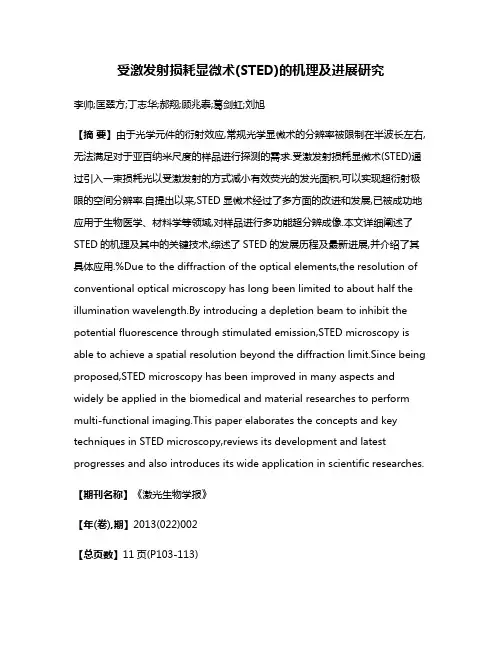
受激发射损耗显微术(STED)的机理及进展研究李帅;匡翠方;丁志华;郝翔;顾兆泰;葛剑虹;刘旭【摘要】由于光学元件的衍射效应,常规光学显微术的分辨率被限制在半波长左右,无法满足对于亚百纳米尺度的样品进行探测的需求.受激发射损耗显微术(STED)通过引入一束损耗光以受激发射的方式减小有效荧光的发光面积,可以实现超衍射极限的空间分辨率.自提出以来,STED显微术经过了多方面的改进和发展,已被成功地应用于生物医学、材料学等领域,对样品进行多功能超分辨成像.本文详细阐述了STED的机理及其中的关键技术,综述了STED的发展历程及最新进展,并介绍了其具体应用.%Due to the diffraction of the optical elements,the resolution of conventional optical microscopy has long been limited to about half the illumination wavelength.By introducing a depletion beam to inhibit the potential fluorescence through stimulated emission,STED microscopy is able to achieve a spatial resolution beyond the diffraction limit.Since being proposed,STED microscopy has been improved in many aspects and widely be applied in the biomedical and material researches to perform multi-functional imaging.This paper elaborates the concepts and key techniques in STED microscopy,reviews its development and latest progresses and also introduces its wide application in scientific researches.【期刊名称】《激光生物学报》【年(卷),期】2013(022)002【总页数】11页(P103-113)【关键词】光学显微;荧光;受激发射;超分辨【作者】李帅;匡翠方;丁志华;郝翔;顾兆泰;葛剑虹;刘旭【作者单位】浙江大学现代光学仪器国家重点实验室,浙江杭州 310027;浙江大学现代光学仪器国家重点实验室,浙江杭州 310027;浙江大学现代光学仪器国家重点实验室,浙江杭州 310027;浙江大学现代光学仪器国家重点实验室,浙江杭州310027;浙江大学现代光学仪器国家重点实验室,浙江杭州 310027;浙江大学现代光学仪器国家重点实验室,浙江杭州 310027;浙江大学现代光学仪器国家重点实验室,浙江杭州 310027【正文语种】中文【中图分类】O4390 引言随着科学技术的不断进步,生物医学,材料学等领域开始对亚百纳米尺度的微结构进行观测与分析,从而对显微技术的发展提出了更高的要求。
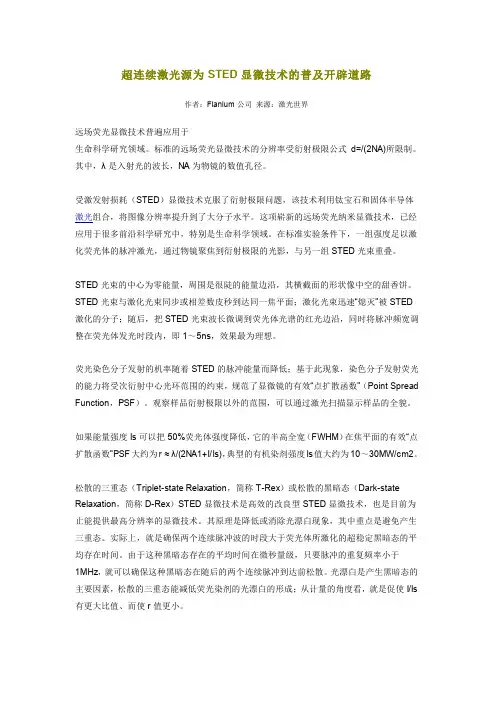
超连续激光源为STED显微技术的普及开辟道路作者:Fianium公司来源:激光世界远场荧光显微技术普遍应用于生命科学研究领域。
标准的远场荧光显微技术的分辨率受衍射极限公式d=/(2NA)所限制。
其中,λ是入射光的波长,NA为物镜的数值孔径。
受激发射损耗(STED)显微技术克服了衍射极限问题,该技术利用钛宝石和固体半导体激光组合,将图像分辨率提升到了大分子水平。
这项崭新的远场荧光纳米显微技术,已经应用于很多前沿科学研究中,特别是生命科学领域。
在标准实验条件下,一组强度足以激化荧光体的脉冲激光,通过物镜聚焦到衍射极限的光影,与另一组STED光束重叠。
STED光束的中心为零能量,周围是很陡的能量边沿,其横截面的形状像中空的甜香饼。
STED光束与激化光束同步或相差数皮秒到达同一焦平面;激化光束迅速“熄灭”被STED 激化的分子;随后,把STED光束波长微调到荧光体光谱的红光边沿,同时将脉冲频宽调整在荧光体发光时段内,即1~5ns,效果最为理想。
荧光染色分子发射的机率随着STED的脉冲能量而降低;基于此现象,染色分子发射荧光的能力将受次衍射中心光环范围的约束,规范了显微镜的有效“点扩散函数”(Point Spread Function,PSF)。
观察样品衍射极限以外的范围,可以通过激光扫描显示样品的全貌。
如果能量强度Is可以把50%荧光体强度降低,它的半高全宽(FWHM)在焦平面的有效“点扩散函数”PSF大约为r ≈ λ/(2NA1+I/Is),典型的有机染剂强度Is值大约为10~30MW/cm2。
松散的三重态(Triplet-state Relaxation,简称T-Rex)或松散的黑暗态(Dark-state Relaxation,简称D-Rex)STED显微技术是高效的改良型STED显微技术,也是目前为止能提供最高分辨率的显微技术。
其原理是降低或消除光漂白现象,其中重点是避免产生三重态。
实际上,就是确保两个连续脉冲波的时段大于荧光体所激化的超稳定黑暗态的平均存在时间。

突破衍射极限的方法1.近场成像基本思路是利用高空间频率信号来获得清晰的物象。
由于需要非常接近样本,因而对于实际应用造成了很大的障碍。
1) superlensZhang X, Liu Z. Superlenses to overcome the diffraction limit.[J]. Nature Materials, 2008, 7(6):435-441.使用负折射率超材料(完美透镜)增强原子力显微镜/显微镜的分辨率。
将负折射率材料靠近目标物体,近场消逝波将被增强。
完美透镜的分辨率不取决于衍射极限,而是取决于放大率和多少消失模被存储2) hyperlensLu D, Liu Z. Hyperlenses and metalenses for far-field super-resolution imaging[J]. Nature Communications, 2012, 3(6):1205.3) microsphere assist imagingWang Z, Guo W, Li L, et al. Optical virtual imaging at 50 nm lateral resolution with a white-light nanoscope[J]. Nature Communications, 2011, 2(1):385-396.4) nearfield scanning optical microscopy2.远场成像可以做到远场高分辨,达到几十纳米的分辨率,通过选择性激活或者灭活荧光团但是这些成像技术仅适用于生物组织样本1)STEDStimulated emission depletion microscopy受激发射减损显微镜https:///wiki/STED_microscopy2) PALMphoto-activated localization microscopy光激活定位显微镜https:///wiki/Photoactivated_localization_microscopy3) STORM随机光学重构显微技术Stochastic optical reconstruction microscopyhttps:///wiki/Super-resolution_microscopy#Stochastic_optical_reconstruct ion_microscopy_.28STORM.293.SOLsuper-oscillatory lens超震荡透镜Berry M V. Exact nonparaxial transmission of subwavelength detail using superoscillations[J]. Journal of Physics A Mathematical & Theoretical, 2013,46(20):2140-2154.。
受激发射损耗显微术及其在生物医学上的应用
郑东
【期刊名称】《现代仪器与医疗》
【年(卷),期】2011(017)001
【摘要】由于受到光学衍射的限制,均匀照明宽视场荧光显微术和激光共焦扫描显微术的分辨率约为200~300nm.近年来受激发射损耗显微术在突破衍射极限以及应用方面取得许多令人瞩目的成果.本文简要介绍受激发射损耗显微术的原理、方法及其在生物医学上的应用.
【总页数】3页(P1-3)
【作者】郑东
【作者单位】北京师范大学分析测试中心,北京100875
【正文语种】中文
【相关文献】
1.近场光学显微术在生物大分子探测与功能研究中的应用 [J], 吴扬哲;蔡继业;陈勇;汪晨熙
2.高分辨率光学显微术在生命科学中的应用 [J], 王娟;汤乐民
3.受激发射损耗显微术(STED)的机理及进展研究 [J], 李帅;匡翠方;丁志华;郝翔;顾兆泰;葛剑虹;刘旭
4.原子力显微术在生物研究中的应用 [J], 陈龙;冯喜增
5.聚乳酸及其共聚物的合成和在生物医学上的应用 [J], 李孝红;袁明龙;熊成东;邓先模;黄志镗
因版权原因,仅展示原文概要,查看原文内容请购买。
突破衍射极限的成像方法综述作者:乌拉郑玉祥来源:《光学仪器》2017年第01期摘要:“衍射极限”实际上不是一个真正的障碍,除非处理远场和定位精度。
这种衍射障碍并不是坚不可摧的,可以利用一些智能技术来突破光学衍射极限。
讨论了四种技术,近场扫描光学显微镜(NSOM)法,受激发射损耗(STED)显微镜法,光激活定位显微镜(PALM)法或随机光学重建显微镜(STORM)法和结构照明显微镜(SIM)法,并且介绍了各自的基本原则与优劣。
NSOM利用纳米级探测器检测通过光纤的极小汇聚光斑,从而获得单个像素的分辨率;PALM和STORM利用荧光探针,实现暗场和荧光的转换,从而观察到极小的荧光团;SIM则是利用栅格图案与样品叠加成像来实现。
其中,STORM具有相对较高的潜力,能够更为有效地突破衍射极限。
关键词:衍射极限;近场显微镜;三维显微中图分类号: O 43文献标志码: Adoi: 10.3969/j.issn.10055630.2017.01.014A review on imaging methods to break the diffraction limitRamzan Ullah1,2, ZHENG Yuxiang1(1.Shanghai UltraPrecision Optical Manufacturing Engineering Center, Department of Optical Science and Engineering,Fudan University, Shanghai 200433, China;2.Department of Physics, COMSATS Institute of Information Technology, Islamabad 45550, Pakistan)Abstract:Notorious term 'diffraction limit' is not actually a true barrier unless we are dealing with far field and localization precision.This diffraction barrier is not impenetrable and can be broken with some intelligent techniques.We discuss here four powerful techniques,nearfield scanning optical microscopy(NSOM),stimulated emission depletion(STED) microscopy,photoactivated localization microscopy(PALM) & stochastic optical reconstruction microscopy(STORM) and structured illumination microscopy(SIM),along with their underlying principles together with pros and cons.NSOM uses a nanometer scale detector or source which compels the light to passthrough the tiny tip of a fiber while keeping the distance between the tip and sample less than λ.At any given moment in a STED microscope,laser light is focused into a small spot by the objective and as a result,all fluorophores within this focused spot radiate fluorescence,which is then gathered by the objective and headed to the detector where it forms a single pixel.Fluorescent probes are employed by STORM/PALM,which are able to toggle between dark states and fluorescent so that with every snapshot taken,only a tiny,optically resolvable portion of the fluorophores is observed.Structured illumination is a wide field technique in which a grid pattern is produced by the interference of diffraction orders which are superimposed on the sample while taking images.STORM has the relatively high potential to effectively break the conventional diffraction barrier with fewer hurdles.Keywords:diffraction limit; nearfield microscopy; threedimensional microscopyIntroductionA microscope is a device used to see objects in intricate detail usually up to the order ofnanoscale.The main factor in determining the quality of a microscope is its resolution which is fundamentally bounded by diffraction limit.Normally,determining the diffraction limit of an imaging system is based on Abbe and Rayleigh criterions[1] which in turn depend on numerical aperture of the lens and wavelength of light being used.With the advent of new technologies different types of microscopes working beyond the limit of diffraction,have been developed which include electron microscopes[23] using electrons as well as optical microscopes using smart optical techniques.Each type has its own pros and cons.We present a short review of some of these optical microscopes.1Nearfield scanning optical microscopy(NSOM)NSOM sometimes abbreviated as SNOM for "Scanning Nearfield Scanning Optical Microscopy" was firstly suggested in 1928[4].NSOM uses a very innovative concept to penetrate the diffraction barrier which is to use a detector or source whose size is in nanometer scale.NSOM compels the light to pass through the tiny tip(whose aperture size is on the order of tens of nanometers) of afiber.Now if this tip is brought very close to the object,the resolution is no more limited by the diffraction,but by the size of the tip aperture as elucidated in Fig 1.So it means the distance between the tip and object must be much smaller than λ.So it breaks the far field resolution limit.Probe resolution is mainly quantified by the diameter of the aperture[5].With the passage of time,more and more advanced techniques have been developed and some are even specific to the type ofsample[6].This technique has revolutionized the field of material characterization especially for nano materials[7].So basically NSOM/SNOM utilizes the near field component of the electromagnetic wave whose propagation is limited to very short distance as opposed to far field light which smears out infinitely until absorbed,refracted or scattered whatever is the case.The propagation distance of a near field photon is proportional to the physical dimensions of its source;hence in order to be observable by the nearfield,the objects have to be in very close proximity of the field.The distance between the tip and object must be less than the dimensions of the aperture of the tip.The amplitude ofthe nearfield light decays exponentially as the negative of the 1st or higher power of the distance from its source.A detailed analysis of the NSOM can be found here[8].Similarly another technique called apertureless near field microscopy reaches beyond the range of simple NSOM[9].1.1Advantages(1) NSOM offers direct relationship between surfacenano features and optical or electronic characteristics along with concurrent mensuration of the topography as well as optical properties (fluorescence).Fig.1Schematic diagram of a NSOM(2) NSOM is substantially effective in characterizing the inhomogeneous materials or surfaces,like nano particles,polymer blends,porous silicon,and biological systems[10].1.2Disadvantages(1) The chief drawback to NSOM is the restricted number of photons coming out of the tiny tip and the miniscule collection efficiency.(2) Long scan time for high resolution images or large areas to be scanned.(3) Only surface features can be studied.2Stimulated emission depletion(STED) microscopyA STED microscope is built on the basis of aconfocal laser scanning microscope(CLSM).A layout of a CLSM is shown in Fig.2.At any given moment,laser light is focused into a small spot by the objective and as a result,all fluorophores within this focused spot radiate fluorescence,which is then gathered by the objective and headed to the detector.The detected signal forms a singlepixel.Then the scanning mirror moves in XY plane to take the next pixels and this goes on until the whole sample is scanned and as a result whole image of the sample is formed.Sometimes,the sample stage is moveable so sample is moved in the XY plane and whole image is formed.A single pixel is obtained for each location.So in order to get a high resolution image,it would take considerable time.Fig.2A schematic diagram of a CLSMThe intensity of the light at the focused spot spreads out in accordance with the point spread function(PSF).For a circular aperture,the PSF exhibits a pattern called “Airy disk”,whose size is proportional to λ/NA where λ is the wavelength of light & NA is numerical aperture.The resolution of CLSM is decided by the size of the PSF:If the focal spot is smaller,so does the each pixel acquired and the resultant image will be crisp and sharp.But if not,resultant image willbe blurred.So the main challenge is to achieve smaller and smaller PSF to get better and better resolution.However,there is a natural diffraction limit in doing this like in any other system and this situation was first described in 1870’s by a German physicist Ernst Abbe(1840—1905) who indicated that the PSF size has a lower limit which is proportional to λ/NA(circular aperture) due to diffraction.This is called the Abbe’s diffraction limit.The basic idea behind STED microscopy is the utilization of nonlinear optics to design a smaller PSF below Abbe’s diffraction limi t.It was Albert Einstein,who in 1917 theoretically anticipated the occurrence of stimulated emission.Stimulated emission is the basic building block of lasers and it also functions as the foundation of STED that cracks the diffraction limit.The STEDmicroscope is largely dependent on two laser pulses which are synchronized.These two synchronized laser pulses are named as 'STED laser' and 'excitation laser' in Fig.3.As can be seen,excitation is carried out by a subpicosecond laser pulse which is tuned to the absorption spectrum of the dye.The excitation pulse is irradiated and focused onto the sample,generating a typical diffraction limited spot of excited molecules.The excitation pulse is instantly chased by a depletion pulse named as STED pulse.The STED pulse is redshifted(increased in wavelength) in frequency to the emission spectrum of the dye,in such a way that its lower energy photons operate only on the excited molecules of the dye under ideal condition,hence,extinguish them to the ground state by stimulated emission.The overall result of the STED pulse is that the influenced excited molecules cannot radiate in the fluorescence regime because their energy is disposed of in the STED pulse.By arranging the STED pulse in doughnut mode spatially,only the molecules in the proximity of the spot are quenched under ideal condition.Fluorescence ideally remains intact at the center of the doughnut,where the STED pulse is evanescing.Fig.3Simplified STED schemeBy increasing the intensity of the STED pulse,the depletion becomes increasingly more functional towards the middle and sufficiently complete at the proximity of the spot.However,the fluorescence is ideally not affected at all at the doughnut hole.Therefore,by increasing the intensity of the doughnutshaped STEDpulse,the fluorescent spot can be gradually shrunk down,theoretically,even up to the size of a single molecule.This intriguing concept is manifesting the fundamental smashing of the diffraction barrier.The crucial element is the saturated diminishing of the fluorescence at any coordinate except the focal point.This microscopy technique is unique in a way that presently the well known super resolution methods like multiphoton fluorescence,the confocal or related microscopes,which can never transcend Abbe’s barrier by more than a factor of 2.In a way,confocal fluorescence and twophoton microscopes just cross the border of the diffraction limitation,without breaking it[11].The resolution of these systems is still restricted by diffraction,as opposed to the STEDmicroscope[12].The actual physical reason behind the breakage of the diffraction barrier is not that fluorescence is hindered,but the saturation of the fluorescence diminishing.Fluorescence diminishing alone is not conducive to the breakage of the diffraction barrier since the focused STEDpulse is also limited by diffraction.However,in this context,saturation means that when the fluorescence at the middle of the doughnut is intact,it is completely stopped at the closest proximity of the doughnut.Thus the fluorescent region is gradually shrunk down without any limit[13].3Photoactivated localization microscopy(PALM) & stochastic optical reconstruction microscopy(STORM)Superresolution optical microscopy technique which is founded on stochastic switching of single molecule fluorescence signal is named as PALM or sometimes also called STORM[14].As in the case of conventional fluorescence microscopy where all fluorophores in the sample are fluorescent and their corresponding images,being diffraction limited,overlap and thus form a smooth but somewhat obscure image.Fluorescent probes are employed by STORM/PALM,which are able to toggle between dark states and fluorescent so that with every snapshot taken,only a tiny,optically resolvable portion of the fluorophores is observed[15].In this way,deduction of their locations with ultra high accuracy from the central locations of the fluorescent spots is possible.With many snapshots of the sample,a final superresolution image can be reenacted from the assembled positions,each catching a random subset of the fluorophores[16].Since its inception in 2006,STORM has gathered many more functionalities[17].With either different emission wavelengths or different activation wavelengths,multicolor imaging can be attained with photoswitchable fluorophores.3D imaging has been actualized with the help of several 3D singleparticle localization methods,inclusive of PSF engineering,biplane imaging,astigmatic imaging and interference.A typical STORM /PALM setup is shown in Fig.4 in which multi color lasers were used.The detail can be found[18].Similarly,Nikon made a new STORM microscope which they name NSTORM with superresolution capable to reconstruct 2D and 3D high resolution images with crystal clear clarity.The detail and specifications can be found here[19].4Structured illumination microscopy(SIM)Structured illumination is awide field technique in which a grid pattern is produced by the interference of diffraction orders which are superimposed on the sample while taking images.The grid pattern is relocated or revolved in steps between recordings of each snapshot set.The snapshot set consists of individual subsets,where each subset is recorded after rotating the grid.Succeeded by the processing with a specially designed algorithm[20],highfrequency information can be extricated from the raw data to develop a reconstructed image with a lateral resolution roughly twice to that of diffractionlimited microscopes[21] and an axial resolution between 150 and 300 nm.Fig.4A PALM and STORM layout in which multi color lasers were used taken from referenceStructuredillumination(SI) leans on both exclusive microscopy procedures and extensive software analysis after exposure.But,because SI is a widefield technique,it is normally capable to capture images at a higher rate than confocalbased schemes like STED[22].The leading concept of SI is to illuminate a sample with patterned light and increase the resolution by measuring the fringes in the Moiré pattern[23] and sample information(which is otherwise unobservable) is extracted from these fringes and computationally reinstated[24].There are some limitations associated with SI.Firstly,the saturating excitation powers induce more photo damage and decline fluorophore photo stability.Secondly,sample drift must be retained well below the resolving distance which is also very challenging.The first limitation can be resolved by combining with other microscopy techniques which use some other nonlinearity like reversible photo activation and stimulated emission depletion.The second limitation delimits livecell imaging and may necessitate faster frame rates.In spite of that,SI is undoubtedly,a strong rival in the competition of applications in the field of superresolution microscopy[25].A comparison table of pros and cons of all of these microscopy techniques given above together with many others can be found at reference[26].5ConclusionAfter discussing these four very powerful techniques,nearfield scanning optical microscopy (NSOM),stimulated emission depletion(STED) microscopy,photoactivated localization microscopy(PALM) & stochastic optical reconstruction microscopy(STORM) and structured illumination microscopy(SIM),of breaking the diffraction limit,we conclude STORM has the high potential to effectively break the conventional diffraction barrier with less hurdles.However,this conclusion is relative as it depends upon the application for which a microscope is required.参考文献:[1]PAWLE Y J.Handbook of biological confocal microscopy[M].New York:Plenum Press,1990.[2]CLARKED R.Review:transmission scanning electron microscopy[J].Journal of Materials Science,1973,8(2):279285.[3]VERNONPARRY K D.Scanning electron microscopy:an introduction[J].IIIVs Review,2000,13(4):4044.[4]NOVOTNY L.From nearfield optics to optical antennas[J].Physics Today,2011(7):4752.[5]LEWENG D,NAHATA A,LEZEC H J,et al.Surface Plasmonenhanced transmission for high throughput NSOM probes[J/OL].[20150810].http:∥/Conference/MNT9/Papers/Lewen/index.html.[6]MICHAELIS J,HETTICH C,MLYNEK J,et al.Optical microscopy using a singlemolecule light source[J].Nature,2000,405:325328.[7]TISLER J,OECKINGHAUS T,STHR R J,et al.Single defect center scanning nearfield optical microscopy on graphene[J].Nano Letters,2013,13(7):31523156.[8]DUNN R C.Nearfield scanning optical microscopy[J].Chemical Reviews,1999,99(10):28912928.[9]YANG T J,LESSARD G A,QUAKE S R.An apertureless nearfield microscope for fluorescence imaging[J].Applied Physics Letters,2000,76(3):378380.[10]HERMAN M A.Scanning nearfield optical microscopy[J].OptoElectronics Review,1997,5(4):295298.[11]HUANG B,BATES M,ZHUANG X W.Super resolution fluorescencemicroscopy[J].Annual Review of Biochemistry,2009,78:9931016.[12]HELL S W,WICHMANN J.Breaking the diffraction resolution limit by stimulated emission:stimulatedemissiondepletion fluorescence microscopy[J].Optics Letters,1994,19(11):780782.[13]HELL S W.Increasing the resolution of farfield fluorescence light microscopy by pointspreadfunction engineering[M]∥LAKOWICZ J.Topics in fluorescence spectroscopy:volume 5:nonlinear and twophotoninduced fluorescence.New York:Plenum Press,1997:361426.[14]HUANG B,BABCOCK H,ZHUANG X W.Breaking the diffraction barrier:superresolution imaging of cells[J].Cell,2010,143(7):10471058.[15]HELL S W.Microscopy and its focal switch[J].Nature Methods,2009,6(1):2432.[16]HELL S W.Farfield optical nanoscopy[J].Science,2007,316(5828):11531158.[17]KAMIYAMA D,HUANG B.Development in the STORM[J].Developmental Cell,2012,23(6):11031110.[18]CHEMIE P.Establishment and optimization of superresolution fluorescence microscopy for multicolour studies of biological systems[D].München,2010.[19]Nikon instrumants Inc.SupperResolution microscope system offering ten times the resolution of convention optical microscopes[EB/OL].[20160402].http:∥/Products/Superresolution/NSTORMSuperResolution.[20]BARLOW A L,GUERIN C J.Quantization of widefield fluorescence images using structured illumination and image analysis software[J].Microscopy Research and Technique,2007,70(1):7684.[21]NEIL M A A,WILSON T,JUKAITIS R.A light efficient optically sectioning microscope[J].Journal of Microscopy,1998,189(2):114117.[22]WILSON T,JUKAITIS R,NEIL M A A,et al.Confocal microscopy by aperture correlation[J].Optics Letters,1996,21(23):18791881.[23]CHASLES F,DUBERTRET B,BOCCARA A C.Optimization and characterization of a structured illumination microscope[J].Optics Express,2007,15(24):1613016140.[24]JUKAITIS R,WILSON T,NEIL M A A,et al.Efficient realtime confocal microscopy with white light sources[J].Nature,1996,383(6603):804806.[25]KARADAGLI D,WILSON T.Image formation in structured illumination widefield fluorescence microscopy[J].Micron,2008,39(7):808818.[26]WILSON S M,BACIC A.Preparation of plant cells for transmission electron microscopy to optimize immunogold labeling of carbohydrate and protein epitopes[J].Nature Protocols,2012,7(9):17161727.(编辑:张磊)龙源期刊网 。
现代生物显微技术的现状与发展趋势在当今的生命科学研究领域,生物显微技术无疑是一把探索微观世界奥秘的关键钥匙。
它不仅让我们能够更清晰地观察细胞和细胞器的结构与功能,还为疾病的诊断和治疗提供了重要的依据。
随着科技的不断进步,现代生物显微技术正以惊人的速度发展,为我们揭示着生命的更多奥秘。
目前,常见的现代生物显微技术包括光学显微镜技术、电子显微镜技术以及近年来崭露头角的超分辨显微镜技术等。
光学显微镜是最基础也是应用最为广泛的一种生物显微技术。
传统的光学显微镜通过可见光的折射和反射来成像,但其分辨率受到光波波长的限制,一般只能达到约 200 纳米。
为了突破这一限制,科学家们研发出了荧光显微镜。
荧光显微镜通过给特定的生物分子标记上荧光染料或荧光蛋白,使其在特定波长的激发光下发出荧光,从而实现对目标分子的观察和追踪。
共聚焦显微镜则是荧光显微镜的进一步发展,它通过在光路中引入针孔,有效地排除了焦平面以外的杂散光,大大提高了图像的清晰度和分辨率。
电子显微镜则是利用电子束来成像,其分辨率远远高于光学显微镜。
其中,透射电子显微镜(TEM)能够穿透样品并形成高分辨率的内部结构图像,常用于观察细胞的超微结构,如细胞器的形态、膜结构等。
扫描电子显微镜(SEM)则通过扫描样品表面并收集反射的电子来生成图像,能够提供样品表面的三维形貌信息,对于观察细胞表面的结构和微生物的形态非常有用。
然而,随着生命科学研究的不断深入,人们对于更清晰、更精细的微观结构观察需求日益迫切。
在这种背景下,超分辨显微镜技术应运而生。
超分辨显微镜技术主要包括受激发射损耗显微镜(STED)、单分子定位显微镜(SMLM)等。
这些技术打破了传统光学显微镜的衍射极限,能够实现几十纳米甚至更高的分辨率,使得我们能够观察到细胞内更小的结构和分子间的相互作用。
在现代生物显微技术的应用方面,医学领域是其重要的应用场景之一。
例如,在病理学诊断中,显微镜技术可以帮助医生观察病变组织的细胞形态和结构,从而准确诊断疾病。
突破光学衍射极限:实现远场纳米级分辨的光学显微镜作者:倪洁蕾程亚来源:《科学》2015年第01期由于光学衍射极限,远场光学显微镜的分辨率仅能达到光波长的一半左右。
在可见光波段,这一极限大约为200纳米。
而对于生命科学研究,往往需要数十纳米甚至更高的分辨率,以获取组织或活细胞内部精细结构的信息。
2014年度的诺贝尔化学奖获得者解决了这一世纪难题。
2014年度的诺贝尔化学奖授予在超分辨光学显微镜领域做出开创性贡献的三位科学家:贝齐格(E.Betzig)、黑尔(S.W.Hell)和莫纳(W.E.Moerner)。
对于很多同行而言,这件事既在意料之中,却也颇显意外。
西方人有一句谚语:“Seeing is believing(眼见为实)。
”因此,成像与观测领域的重大突破一直为诺贝尔奖所青睐。
300余年前,当荷兰科学家列文虎克(A.van Leeuwenhoek)利用自己搭建的显微镜观察水珠时,他意外地发现了悬浮在水滴中的细小浮游微生物,从此向世人打开了进入微观世界的大门。
从几何光学角度看,通过合理设计光学成像系统,光学显微镜具备实现任意放大倍率的能力。
然而,人们身处的世界在本质上是量子世界,最终一切物质都必须用“波”的概念来描述,对光自然也不例外。
因此,当人们利用光波来进行显微观测时,量子力学中的不确定性原理为光学显微镜的分辨率设置了一道屏障,即光学衍射极限。
自从1873年德国科学家阿贝(E.Abbe)首次提出光学衍射极限的概念开始,直到20世纪末,人们一直认为光学显微镜所能够看清的物体的最小尺寸大约为光波长的一半左右(对于可见光而言,这一极限尺寸大约在200纳米)。
这意味着科学家们可以辨别完整细胞,以及其中一些被称为细胞器的组成部分。
然而,他们却无法分辨一个正常大小的病毒或者单个蛋白质。
在这样的背景下,即便对于很多一流的光学科学家,他们也已形成了一个思维定势,认为突破光学衍射极限在理论上是一件不可能的事情。